A) a decrease in demand combined with an increase in supply
B) an increase in both demand and supply
C) an increase in price
D) a decrease in both demand and supply
E) an increase in demand combined with a decrease in supply
Correct Answer

verified
Correct Answer
verified
Multiple Choice
A decrease in quantity demanded is represented by a
A) movement upward and to the left along the demand curve.
B) rightward shift of the supply curve.
C) leftward shift of the demand curve.
D) rightward shift of the demand curve.
E) movement downward and to the right along the demand curve.
Correct Answer

verified
Correct Answer
verified
Multiple Choice
When the demand for good A increases,
A) the equilibrium price and equilibrium quantity will decrease.
B) the equilibrium price will decrease, but the equilibrium quantity will increase.
C) a surplus will result.
D) the equilibrium price will rise, but the equilibrium quantity will decrease.
E) the equilibrium price and equilibrium quantity will increase.
Correct Answer

verified
Correct Answer
verified
Multiple Choice
The demand curve is P = 700 - 10QD.The supply curve is P = 400 + 5QS.At market equilibrium, the equilibrium quantity is _______ and the equilibrium price is _______ .
A) 20; 500
B) 500; 20
C) 300; 15
D) 0.05; 5
E) 5; 0.05
Correct Answer

verified
Correct Answer
verified
Multiple Choice
If A and B are substitutes and the price of A rises, we will observe
A) an increase in the equilibrium price but a decrease in the equilibrium quantity of B.
B) a decrease in the equilibrium price and the equilibrium quantity of B.
C) an increase in the equilibrium price and the equilibrium quantity of B.
D) a decrease in equilibrium price but an increase in the equilibrium quantity of B.
E) a decrease in the demand for A.
Correct Answer

verified
Correct Answer
verified
Multiple Choice
When a market is in equilibrium,
A) supply equals demand.
B) the number of buyers equals the number of sellers.
C) firms are producing the maximum quantity possible given the existing technology.
D) there is neither a surplus nor a shortage.
E) the quantity supplied is greater than or equal to the quantity demanded.
Correct Answer

verified
Correct Answer
verified
Multiple Choice
An increase in income
A) decreases the demand for turnips if turnips have a very low price.
B) increases the demand for turnips if a turnip is an inferior good.
C) increases the supply of turnips.
D) decreases the supply of turnips.
E) increases the demand for turnips if a turnip is a normal good.
Correct Answer

verified
Correct Answer
verified
Multiple Choice
Use the table below to answer the following questions.
Table 3.5.3 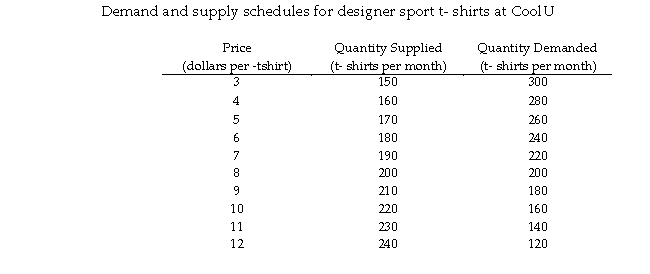 -Refer to Table 3.5.3.Suppose that the price of a designer sport t- shirt is $10.The market has leading to .
-Refer to Table 3.5.3.Suppose that the price of a designer sport t- shirt is $10.The market has leading to .
A) a shortage; a rise in the price
B) a shortage; a fall in the price
C) a surplus; a fall in the price
D) an equilibrium; no change in the price
E) a surplus; a rise in the price
Correct Answer

verified
Correct Answer
verified
Multiple Choice
Use the figure below to answer the following questions.
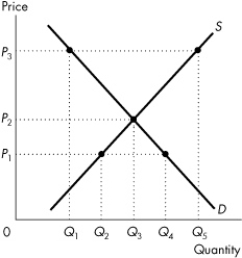 Figure 3.4.1
-At price P3 in Figure 3.4.1,
Figure 3.4.1
-At price P3 in Figure 3.4.1,
A) this market is in equilibrium.
B) there is a tendency for the price to rise.
C) equilibrium quantity is Q5.
D) there is a shortage in the amount of Q5 - Q1.
E) there is a surplus in the amount of Q5 - Q1.
Correct Answer

verified
Correct Answer
verified
Multiple Choice
Use the figure below to answer the following questions.
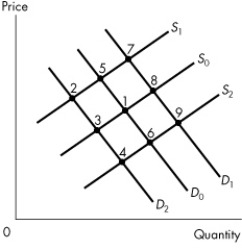 Figure 3.5.2
Original equilibrium at 1.
-Refer to Figure 3.5.2, which represents the market for cow manure.If the price of milk, a complement in production of manure, rises, what is the new manure equilibrium, ceteris paribus?
Figure 3.5.2
Original equilibrium at 1.
-Refer to Figure 3.5.2, which represents the market for cow manure.If the price of milk, a complement in production of manure, rises, what is the new manure equilibrium, ceteris paribus?
A) 8
B) 3
C) 9
D) 5
E) 6
Correct Answer

verified
Correct Answer
verified
Multiple Choice
The demand curve for knobs is P = 75 - 6QD and the supply curve for knobs is P = 35 + 2QS.What is the equilibrium price of a knob?
A) $5
B) $45
C) $40
D) $10
E) $75
Correct Answer

verified
Correct Answer
verified
Multiple Choice
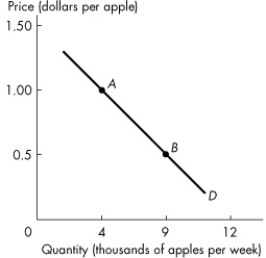 Figure 3.2.1
-Which one of the following would result in a movement from point A to point B in Figure 3.2.1?
Figure 3.2.1
-Which one of the following would result in a movement from point A to point B in Figure 3.2.1?
A) an increase in population
B) a rise in the price of bananas
C) public concern about chemicals sprayed on apples
D) a rise in the price of oranges
E) a fall in the price of apples
Correct Answer

verified
Correct Answer
verified
Multiple Choice
Suppose we observe a fall in the price of good A and a decrease in the quantity of good A bought and sold.Which one of the following is a likely explanation?
A) The law of demand is violated.
B) The supply of A decreased.
C) The supply of A increased.
D) The demand for A increased.
E) The demand for A decreased.
Correct Answer

verified
Correct Answer
verified
Multiple Choice
Today, the price of peanuts increases.Peanut butter producers and peanut butter consumers expect that the price of peanut butter will rise in the future.In the current market for peanut butter, the equilibrium price rises and the equilibrium quantity increases.It must be the case that
A) the demand for peanut butter increased by more than the supply of peanut butter increased.
B) peanut butter producers and peanut butter consumers have incorrect expectations.
C) the supply of peanut butter decreased by more than the demand for peanut butter decreased.
D) the supply of peanut butter decreased by more than the demand for peanut butter increased.
E) the demand for peanut butter increased by more than the supply of peanut butter decreased.
Correct Answer

verified
Correct Answer
verified
Multiple Choice
Use the table below to answer the following questions.
Table 3.1.1  -Refer to Table 3.1.1.In 2017, the relative price of cola in terms of tea is
-Refer to Table 3.1.1.In 2017, the relative price of cola in terms of tea is
A) 2.00.
B) 1.00.
C) 0.91.
D) 2.20.
E) 1.10.
Correct Answer

verified
Correct Answer
verified
Multiple Choice
If a turnip is an inferior good, then, ceteris paribus, an increase in the price of a turnip will
A) decrease the quantity of turnips supplied.
B) decrease the demand for turnips.
C) increase the demand for turnips.
D) decrease the quantity of turnips demanded.
E) increase the supply of turnips.
Correct Answer

verified
Correct Answer
verified
Multiple Choice
Use the table below to answer the following questions.
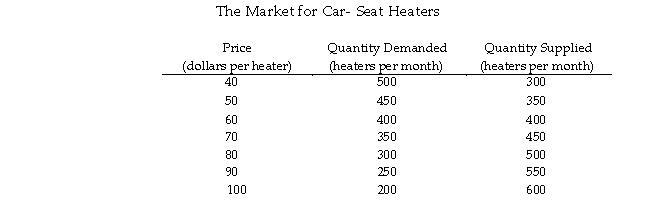 -Refer to Table 3.5.1.Suppose the cost of production rises and supply decreases by 100 units at each price.The new equilibrium price is $ _______and equilibrium quantity is _______ units.
-Refer to Table 3.5.1.Suppose the cost of production rises and supply decreases by 100 units at each price.The new equilibrium price is $ _______and equilibrium quantity is _______ units.
A) 70; 350
B) 50; 350
C) 60; 400
D) 70; 450
E) 50; 450
Correct Answer

verified
Correct Answer
verified
Multiple Choice
When the price of good A rises, the supply curve of good B shifts rightward.Which of the following statements are true?
A) A and B are complements in production.
B) A and B are complements.
C) A is a factor used in the production of B.
D) A and B are substitutes.
E) A and B are substitutes in production.
Correct Answer

verified
Correct Answer
verified
Multiple Choice
Farm land can be used to produce either cattle or corn.If the demand for cattle increases, then the
A) demand for corn decreases.
B) supply of corn decreases.
C) demand for corn increases.
D) supply of corn increases.
E) price of corn falls.
Correct Answer

verified
Correct Answer
verified
Multiple Choice
Use the table below to answer the following questions.
 -Refer to Table 3.5.1.The equilibrium price is $_______ and the equilibrium quantity is _______ heaters per month.
-Refer to Table 3.5.1.The equilibrium price is $_______ and the equilibrium quantity is _______ heaters per month.
A) 50; 350
B) 80; 300
C) 50; 450
D) 60; 400
E) 80; 500
Correct Answer

verified
Correct Answer
verified
Showing 161 - 180 of 185
Related Exams